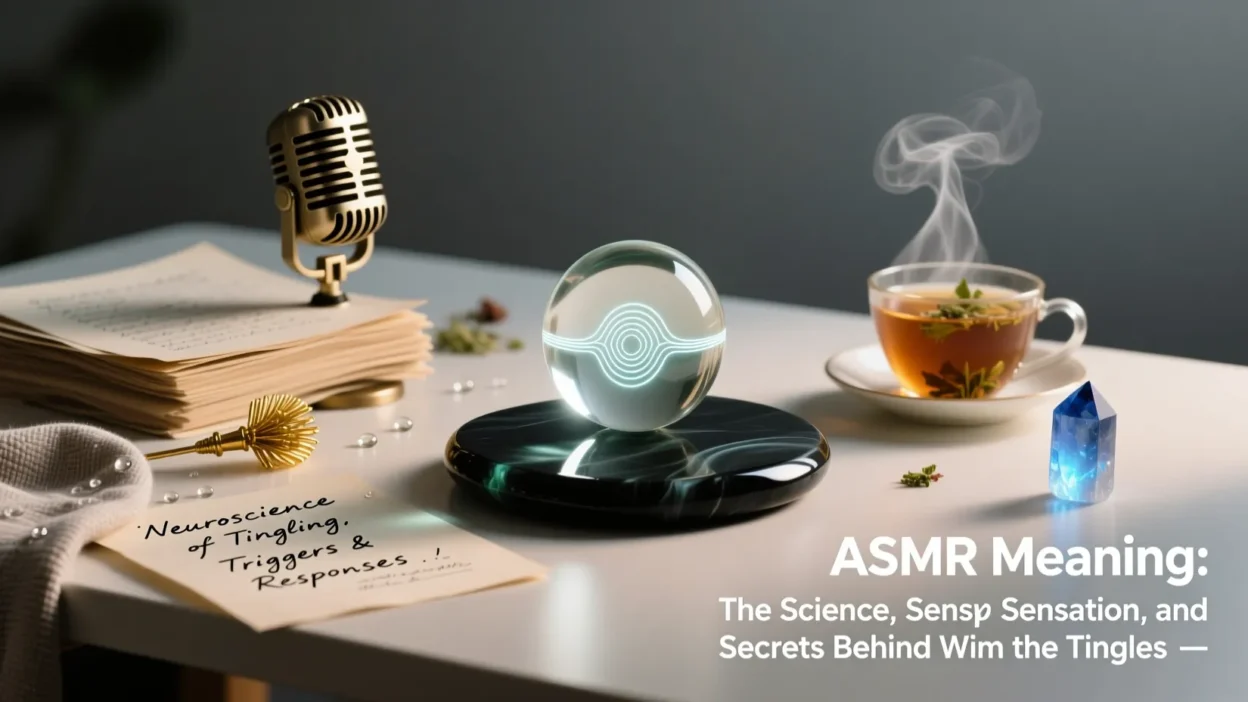If you’ve ever felt a wave of gentle tingles flow from your scalp down your spine while listening to whispers, tapping, or soft rustling sounds, you’ve experienced something called ASMR. This mysterious sensation has taken the internet by storm, with millions tuning in to YouTube and TikTok videos designed to trigger it.
But what exactly is ASMR? Why does it affect some people deeply while others feel nothing at all? And is there real science behind it—or is it just in our heads?
Let’s unpack everything you need to know about Autonomous Sensory Meridian Response (ASMR)—what it means, how it works, its benefits, and what researchers still don’t fully understand.
What Does ASMR Mean?

ASMR stands for Autonomous Sensory Meridian Response. Each word helps explain the phenomenon:
- Autonomous – it happens naturally, without conscious effort.
- Sensory – it’s triggered by the senses (mainly sound and sight).
- Meridian – refers to the body’s energy pathways or peak sensations.
- Response – it’s your body’s reaction to a trigger.
In simple terms, ASMR is a tingling, soothing feeling that starts at the scalp and often travels down the neck, shoulders, and spine. It’s usually triggered by soft sounds, gentle voices, slow movements, or personal attention.
What Does ASMR Feel Like?
People who experience ASMR describe it as:
- A pleasant tingling or “brain massage.”
- A calming, trance-like state similar to meditation.
- A feeling of comfort, warmth, and emotional security.
- A slower heartbeat and reduced tension.
It’s often compared to the feeling you get during a haircut, a massage, or when someone speaks to you softly in a caring tone.
However, not everyone feels it. Around 1 in 5 people experience ASMR strongly, while others may not feel any physical response.
The Science Behind ASMR

ASMR isn’t magic—it’s deeply tied to how our brain and body respond to sensory input.
Recent studies using brain imaging have revealed that:
- ASMR activates reward and emotion centers such as the nucleus accumbens and medial prefrontal cortex—the same regions linked with comfort and bonding.
- During ASMR videos, heart rate drops by 3–4 beats per minute on average.
- Endorphins, serotonin, and oxytocin—“feel-good” chemicals—are likely released, explaining why ASMR feels emotionally satisfying.
This combination of physiological and emotional effects helps explain why ASMR can reduce anxiety, improve sleep, and boost overall relaxation.
Why Do Only Some People Experience ASMR?
Not everyone can experience ASMR. Scientists believe it comes down to a mix of neurology, personality, and past experiences:
- Brain connectivity: People with ASMR show greater neural links between sensory and emotional regions.
- Personality: ASMR-sensitive individuals often score higher in openness and empathy, meaning they’re more responsive to subtle emotional cues.
- Childhood experiences: Those who had comforting, nurturing interactions early in life (like being read to softly or brushed gently) may be more likely to feel ASMR.
- Expectations: Awareness can influence experience—if you know what to look for, your brain may tune in more easily.
Common ASMR Triggers
ASMR triggers vary from person to person, but they typically fall into a few categories:
| Category | Common Triggers | Description |
|---|---|---|
| Auditory | Whispering, tapping, brushing, page-turning | Soft, repetitive sounds that stimulate auditory nerves. |
| Visual | Hand movements, slow folding, painting, makeup application | Visual cues that mimic personal attention or care. |
| Tactile (Simulated) | Hair brushing, scalp touching, massage roleplays | Trigger the illusion of touch and comfort. |
| Environmental | Rain, typing, wind, ocean sounds | Nature-inspired background noises for relaxation. |
Different combinations of these triggers can amplify the ASMR response depending on the listener’s preferences.
ASMR and Mental Health Benefits
Although ASMR isn’t a medical treatment, many use it as a therapeutic tool for mental well-being.
Documented benefits include:
- Reduced stress hormones (cortisol)
- Improved sleep quality and faster sleep onset
- Lower anxiety and panic frequency
- Enhanced focus and mood stabilization
- Deep relaxation similar to mindfulness meditation
ASMR acts like a gentle “reset” for the nervous system—offering comfort without medication or formal therapy.
What ASMR Is Not
ASMR is often misunderstood, so it’s important to separate fact from fiction:
- ❌ Myth: ASMR is sexual.
✅ Truth: It’s not. The response is non-sexual, driven by sensory pleasure and emotional safety. - ❌ Myth: Everyone should feel it.
✅ Truth: Many people don’t, and that’s perfectly normal—ASMR is a unique neurological quirk. - ❌ Myth: It’s just a placebo effect.
✅ Truth: Scientific scans show distinct brain activity patterns in ASMR experiencers, proving it’s a genuine physiological response.
ASMR vs. Other Relaxation Techniques
| Method | What It Involves | Primary Benefit | Duration of Effect |
|---|---|---|---|
| ASMR | Sensory triggers (sound & sight) | Instant relaxation, calm | Short-term but repeatable |
| Meditation | Controlled breathing, mindfulness | Mental clarity & inner peace | Long-term emotional balance |
| White Noise | Steady background sounds | Focus, sleep aid | Continuous support |
| Music Therapy | Rhythmic, harmonic sound | Emotional regulation | Sustained mood improvement |
ASMR uniquely combines sensory stimulation and emotional intimacy, offering an immediate and personalized sense of calm.
Addressing Weaknesses in ASMR Research
Early studies on ASMR had several weaknesses—but newer research is closing those gaps.
| Old Limitation | Updated Research Approach |
|---|---|
| Small, biased samples (only ASMR fans) | Larger, mixed-participant studies now include non-ASMR groups for comparison. |
| Subjective reports (“I felt tingles”) | Objective tracking using EEG, heart rate, and skin conductivity data. |
| Short-term results only | Longitudinal studies now explore lasting mental health benefits. |
| Trigger inconsistency | Researchers categorize triggers by sensory type for more accurate analysis. |
| Lack of control over placebo effects | Blind studies help confirm genuine physiological ASMR reactions. |
These improvements are helping scientists understand ASMR as a legitimate psychophysiological phenomenon, not a social media fad.
Frequently Asked Questions (FAQs)
🌀 Is ASMR scientifically proven?
Yes. Brain scans show consistent activation in emotional and sensory areas during ASMR triggers.
😴 Can ASMR help with sleep?
Absolutely. Many people use ASMR before bed because it lowers heart rate and reduces anxiety.
⚠️ Can ASMR be harmful?
Generally no, but some people find certain sounds irritating or overstimulating. It’s best to choose triggers that feel calming.
🧘 Is ASMR similar to meditation?
Yes—both promote relaxation and mindfulness. ASMR just uses sensory cues instead of focused breathing.
The Future of ASMR
ASMR has evolved far beyond its YouTube roots. It’s now influencing:
- Advertising: Brands use ASMR to evoke emotional engagement.
- Mental health apps: ASMR-based soundscapes are integrated into digital wellness platforms.
- Therapy and medicine: Hospitals experiment with ASMR-inspired relaxation content for patients with anxiety or insomnia.
Soon, AI may deliver personalized ASMR experiences that adapt sound, tone, and rhythm to your mood or heart rate—turning relaxation into a truly individualized science.
Conclusion
ASMR is a powerful reminder that simple sensory moments can profoundly influence our emotions and biology. While science continues to unravel its mysteries, millions already use it to relax, sleep, and reconnect with calmness in a noisy world.
Future research—built on larger studies, objective measures, and long-term analysis—will help validate ASMR as a legitimate wellness tool.
If you’ve never tried it, start small: listen to soft tapping, watch gentle hand movements, or close your eyes to quiet whispering. You might discover your mind’s most peaceful reset button—hidden in the sound of silence.



